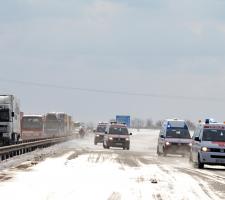
AustriaTech aims to help the implementation of cross border traffic information
Seamless multi-modal traveller information services are becoming reality in the Danube Region.
On 15th of March 2013, a Hungarian national holiday of which many people were unaware, unexpected extreme winter weather paralysed Hungary as well as large parts of Slovakia.Several thousand people were stranded on the region’s highways and the railways incurred delays of several hours. Not only did the transport system in the affected regions break down, the information flow to neighbouring countries was very slow-going. Motorists coming from several parts of Europe were stopped at the Austrian borders because of the severe winter conditions, but they did not receive information about alternative travel possibilities or real-time information about the delays ahead of them. The communication flow between the countries did not work properly and the traveller information was poor. The results were incredibly long traffic jams and many displeased travellers, neither of which is acceptable in today’s connected world.
This situation revealed that in regions with many countries, lots of borders and boundaries, cooperation and information exchange is vital. In this case the situation was made even more complicated because the different countries used different languages.
The aim within the Central and Eastern Europe (CEE) region is to provide multi-modal cross-border traveller information which, ideally, should include real-time information. Cross-border cooperation is vital because, looking at the geographical situation, a traveller needs less than one hour by train or car to travel from Bratislava to Vienna. Equally, the trip between Budapest and Vienna takes less than three hours. As there are no longer any physical borders hindering European travellers, it is not acceptable for local or national traveller information services stops at those borders.
There are several good examples of local or national traveller information services existing within the CEE region - the best being the Czech traveller information portal “idos” (
Austria as a role model
In Austria, the Graph Integration Platform (GIP) which references the country’s transport network, is established by national ITS law and became fully operational at the beginning of this year. The GIP combines the transport networks of 11 data owners and forms the basis of a newly-established country-wide traveller information service known as VAO (Verkehrsauskunft Österreich) which is funded by the Austrian Climate and Energy Funds. This multi-modal service includes road transport as well as public transport, walking and cycling information is currently in the beta-testing phase. In the second half of 2013 a public test version will be available, providing multi-modal traveller information services across Austria. The mobility agencyMoreover, other Central European countries are also working on regional and national traveller information solutions. Looking at these approaches and the maturity of the solutions it is clear that the provision of cross-border services is not a technical problem. Also the availability of data cannot be the key problem, as data is already provided for the local systems.
However, the information is not currently available to the cross-border traveller. Martin Russ, Managing Director of AustriaTech says: “Currently the main obstacles are the lack of organisational structures and information exchange agreements.”
Organisational structures will need to be established based on cooperation and trust between all data and information providers. “Operators need to understand that a sustainable transport system can only be guaranteed by cooperating with neighbouring operators and not in competition,” says Russ.
The basis for establishing these organisational structures will be information exchange agreements that clearly regulate rights to data as well as responsibilities concerning the quality of data to be delivered. Additionally, security of past investments needs to be ensured. No operator or administration is willing to endure large write-downs of equipment costs due to stopping existing operative systems.
Last autumn the forerunner operators and cities in Central Europe committed themselves to work on the installation of multi-modal cross-border traveller information services. This has been realised in the European Digital Traffic Infrastructure Network for Intelligent Transport Systems project (
The system is currently in the deployment phase and is based on the exchange of travel related information between operators and authorities based on bilateral data exchange agreements and includes geographical information, public transport timetables and road transport information.
This exchange results in the enlargement and improvement of the existing national or local routing and information services in each country by providing cross-border information. Therefore services such as Austria’s VAO could work in Hungary as well and the Hungarian system vice versa. In future, travellers using all modes of transport will be able to use their information device (app- or web-based service) in their native language and receive route guidance for foreign cities and regions.
As data and information is provided directly from the operators, accurate services and a high quality are ensured. By end of 2014 it is expected that at least for parts of Austria, Southern Moravia, Bratislava, western parts of Hungary and Italy’s Friuli Venetia Giulia, Modena and Ferrara regions will have multi-modal cross-border services to inform the travelling public. The system has been set up to enable real-time information for all modes to be delivered to the travellers.
Once the links for information exchange have been finalised, a cross-border traveller information service can be introduced providing not only regular travel information for all modes but also real-time information about unexpected travel conditions. Travellers will feel well informed and secure about their transport choice as travel-related information is delivered in the highest quality directly from operators and authorities, resulting in seamless cross-border trips across the Danube Region.
If the system had been available in March 2013, the traffic chaos encountered throughout the region would have been avoided and once it is introduced such problems should be consigned to history.
AustriaTech was founded in 2005 as a subsidiary of the Austrian Ministry of Transport, Innovation and Technology to maximise the societal deployment of new technologies in traffic and transport. It acts as an agency for the ministry and pursues long-term strategies for sustainable transport solutions and receives a legal mandate from the ITS law which requires national implementation of the European ITS Directive. As an agency, AustriaTech facilitates and carries out a common ITS strategy and is tasked with the observation, documentation and harmonisation of mobility services.













